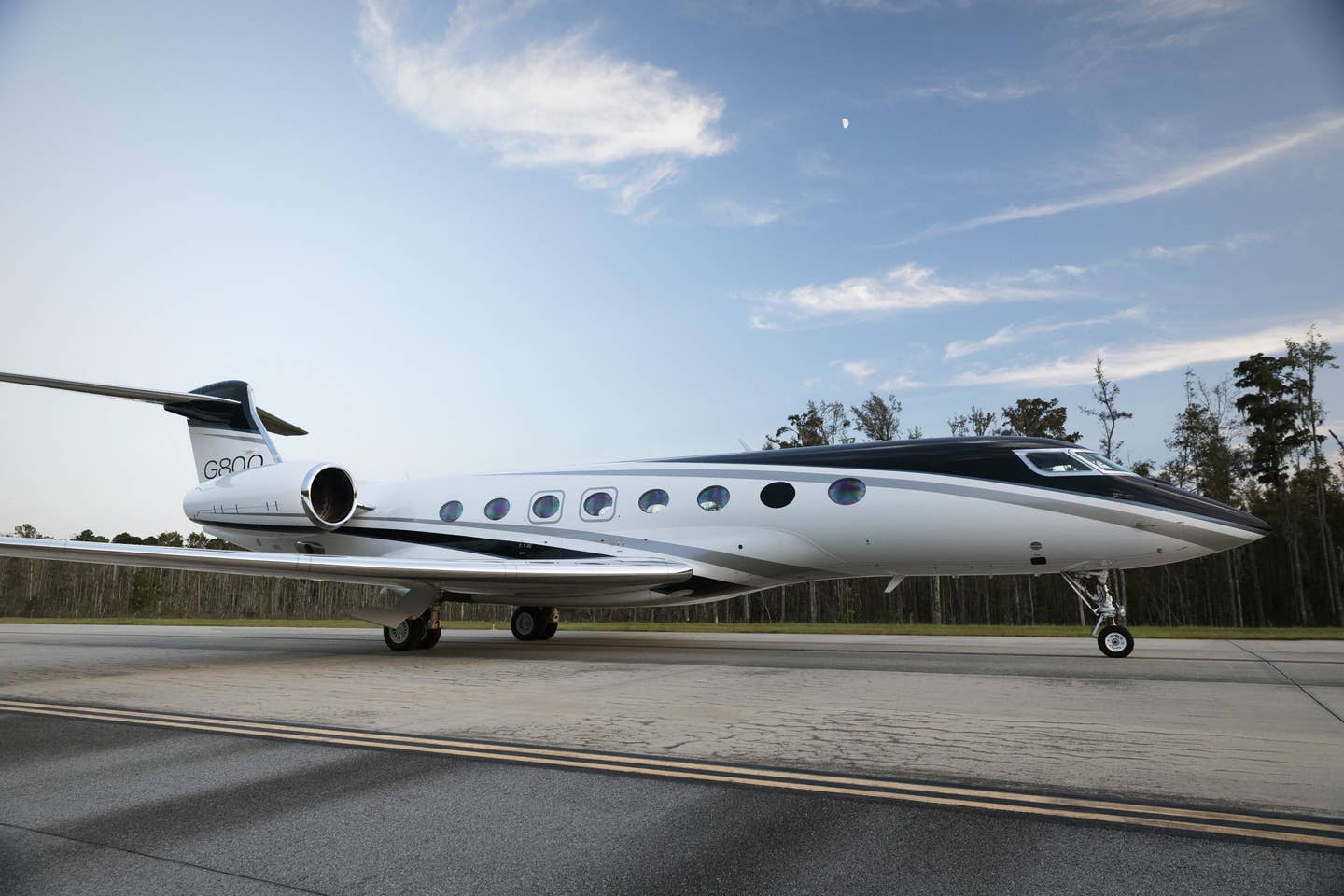
The G400 (pictured here) and G800 fill in important niche markets within the Gulfstream business and private aviation product line. Gulfstream Aerospace
Perhaps it was a foregone conclusion that Gulfstream would fill in the blanks numerically in its lineup from the large cabin midsize G280 to the nearly-certificated ultralong range G700.
With a stroke the company officially recognized those models, the G400 and the G800, in an event Monday evening.
FLYING was invited to a sneak preview of the new lineup last month at Gulfstream’s headquarters in Savannah, Georgia. We found the company well on its path to certificating both models, using strategic commonality between the aircraft in its fleet.
The G400: The Sweet Spot
The first of the two jets added to the rollup, the G400, takes position between the G280 and the G500 and G600—it’s not a replacement for any other model on the current roster.
“It’s a sweet spot in the customer base,” said Gulfstream’s president Mark Burns, with strong demand for an aircraft with a large, stand-up cabin that can cover 4,000 nm and cost about $35 million.
In fact, the G400 is projected to range up to 4,200 nm at Mach 0.85 and 3,950 nm at Mach 0.88.
Gulfstream will start building the first airplane in the beginning of 2022. The company predicts the aircraft will be in service in 2025.
“It was a three-airplane program” from the beginning, said Burns of the G400/G500/G600 line.
The G400 will use Pratt & Whitney PW800-series engines—the -812′s fan diameter is a little less than that used for the 500/600 (which has a 44-in. fan).
With seating for up to 12 passengers, the G400 will have the same cabin width as the G500/G600. Much of the same technology found in the G700 will translate over to the smaller model, as well. Gulfstream is the first OEM to introduce a new product in the large-cabin segment in more than a decade.
The Symmetry flight deck up front and a similar wing to the G500/G600 enable the common type ratings Gulfstream intends—to make the G400 more affordable overall, and cost effective for flight departments to adopt and bring into service.
Gulfstream plans to build a total of five aircraft initially to put into flight test, with a first flight taking place in about 18 months. The G400 carries a $34.5 million price tag—the base price plus a limited number of options, as the standard-issue airplane will come almost fully equipped.
The G800: Just a Little Longer
Even closer to daylight is the new top-of-the-line Gulfstream, the G800. With the most extensive range and the fastest top speed, the ultralong-range jet is anticipated to stretch its legs up to 8,000 nm at Mach 0.85, and cruise out to 7,000 nm at Mach 0.90. Its MMO? Mach 0.925.
With that reach, Gulfstream now closes in on the ultimate range question: Do we fly to the left or to the right to get to where we want to go on the other side of the globe?
“[The G800 will] ultimately replace the G650,” said Burns, “but we’ve had a wonderful run with sales over the last couple of years, so we’ll keep building it.” The backlog will give Gulfstream an additional means of support as it brings the latest models in the series to fruition.
The G800 will seat up to 19 passengers in the cabin based on the G700′s interior already undergoing its own proving missions on long-distance segments. The jet shares a common engine with the G700 too—the Rolls Royce Pearl 700—which produces 18,250 lbs. of thrust per engine, can operate on sustainable aviation fuel, and meets Stage 5 noise limits.
Steep approach capability means more airports will be accessible to both the G700 and G800—and the larger airplane will still meet a takeoff distance of 6,000 ft. at its max takeoff weight. Maximum cruise altitude tops out at FL 510.
Up front, the G800 features the Symmetry flight deck, with its combined vision system—integrating synthetic vision (SVS) and enhanced vision (EVS), with dual heads-up displays and Gulfstream’s Predictive Landing Performance System.
With a standard price of $71.5 million, the G800 is a little closer to the finish line: Gulfstream expects entry into service in 2023. A first test aircraft had rolled out into the sun in mid-September and was cloaked in its paint scheme in time for the rollout event on October 4. A second test aircraft has already been produced—with many common processes in certification to that of the G700.
The Long-Range View
Burns spoke to the 15-year investment cycle sunk into R&D, from the beginning of General Dynamics’ ownership of Gulfstream. Eleven airplanes have debuted under his watch—with six aircraft introduced in the past eight years.
The ability to adjust the production flow within a family of related aircraft models allows for a level of optimization within the manufacturing facility that gives Gulfstream the power to flex with the market.
Burns called out Gulfstream’s “unmatched ability to invest in our products with new technologies” owing to “the support that we have form our parent company, General Dynamics.” Burns credited this support specifically to the progress already made on the G400 and G800: “That was the result of [its] long-term investment focus, and it’s what sets us apart.”

Sign-up for newsletters & special offers!
Get the latest FLYING stories & special offers delivered directly to your inbox






